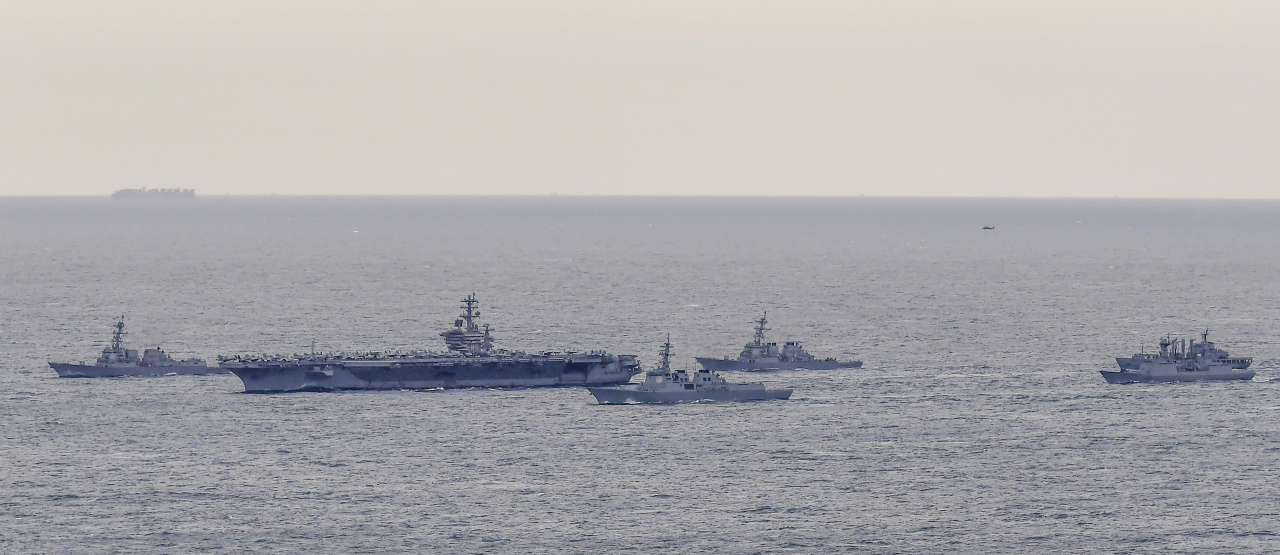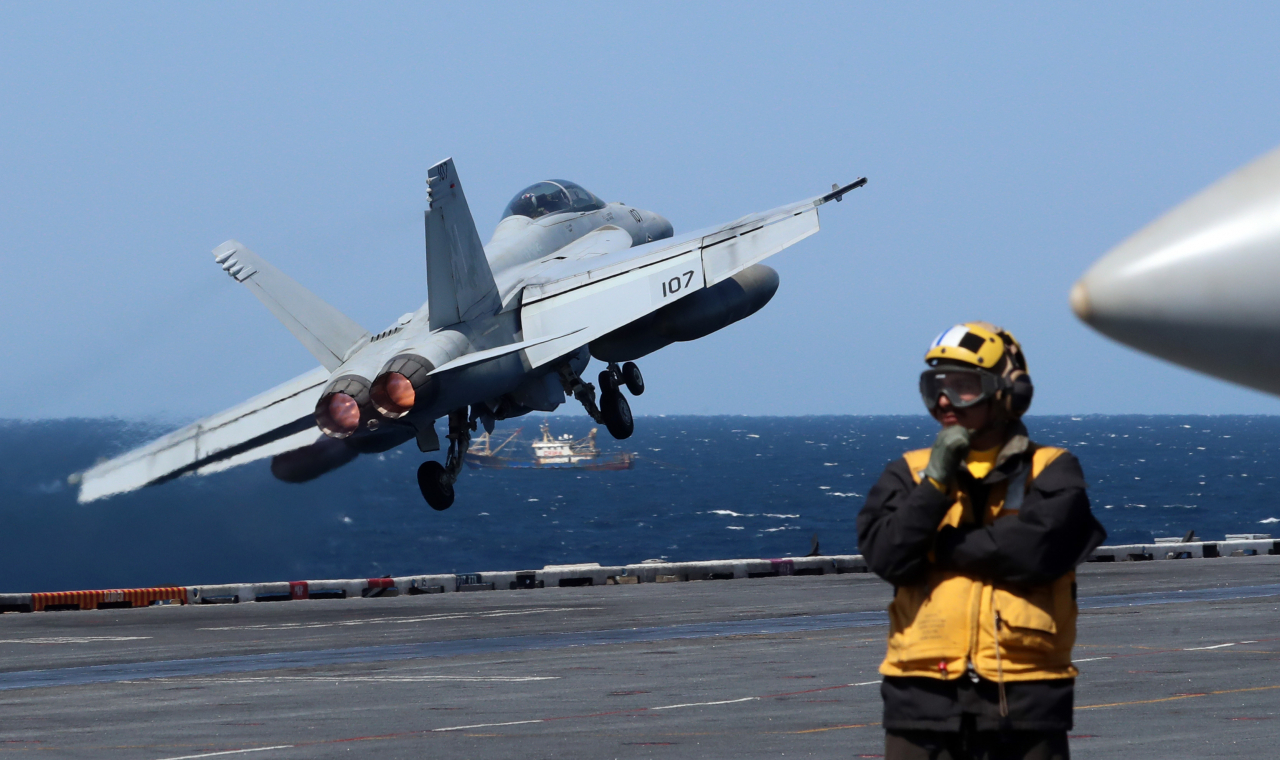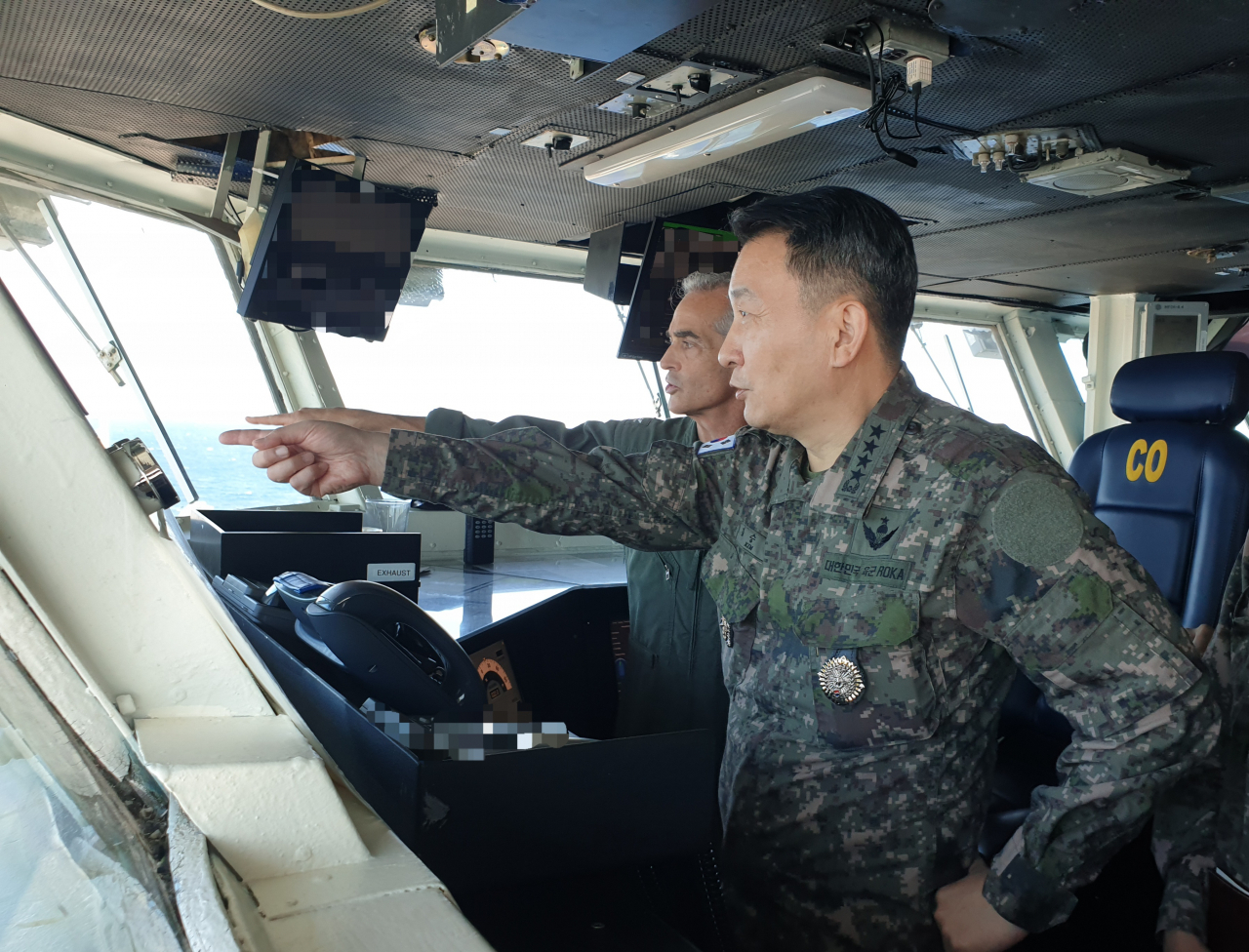N.Korea fires 2 missiles as US aircraft carrier arrives in Busan
By Ji Da-gyumPublished : March 27, 2023 - 16:16

North Korea fired two ballistic missiles toward waters off its eastern coast on Monday, in an apparent protest against combined military exercises between the South Korean and US navies that featured a US aircraft carrier in international waters near the Korean Peninsula.
The US Navy’s supercarrier USS Nimitz, capable of carrying up to 90 aircraft, and its strike group that includes warships armed with guided-missiles were set to dock at a naval base in Busan on Tuesday, marking the first such anchoring since last September.
The two short-range ballistic missiles were launched from the area of Junghwa County in North Hwanghae Province, which borders Pyongyang, from 7:47 a.m. to 8 a.m. local time, South Korea’s Joint Chiefs of Staff said Monday.
The missiles traveled around 370 kilometers and flew in a northeastward direction at 45 degrees before hitting an uninhabited island located in waters off Kilju County, North Hamgyong Province, the military said without further details.

North Korea’s missile launches came “just before” the US Navy’s 100,000-ton nuclear-powered aircraft carrier, the USS Nimitz (CVN-68), and its strike group began staging combined military exercises with South Korean Navy warships in international waters south of Jeju Island on Monday morning.
“The exercises were intended to improve the alliance’s capabilities to stage combined military operations amid escalating nuclear and missile threats from North Korea and enhance the viability of US extended deterrence by deploying the US strategic asset,” South Korea's Navy said Monday.
The navies have strengthened their combined operational capabilities and interoperability by staging various maritime drills, including practicing procedures of escorting an aircraft carrier and conducting anti-air warfare.
The US Navy’s Carrier Strike Group 11, including the guided-missile cruiser USS Bunker Hill as well as guided-missile destroyers USS Wayne E. Meyer and USS Decatur, were mobilized for the combined naval drills alongside the South Korean Navy’s destroyer Sejong the Great with the Aegis combat system, destroyer Choi Young and fast combat support ship Hwacheon.
Monday’s naval drills were part of the Warrior Shield program in which the allies have staged around 20 field training exercises across South Korea in connection with the computer simulation-based Freedom Shield exercise that ended March 23.

South Korean Joint Chiefs of Staff Chairman Gen. Kim Seung-kyum was on board the USS Nimitz on Monday and was briefed on the combined naval drills, according to the JCS.
Gen. Kim underscored that the “South Korea-US alliance will sternly and overwhelmingly respond to any provocations and aggressions by the enemy,” denouncing North Korea for seriously threatening the security of the Korean Peninsula and the region by continuing to launch ballistic missiles and indicating its intent to aggressively use nuclear weapons.
“The deployment of the carrier strike group to the Korean Peninsula and the combined maritime exercises between South Korea and the US demonstrate a resolute determination and capabilities to maintain the alliance’s firm combined defense posture and deter any provocations by the enemy,” Kim said.
The Nimitz carrier strike group was also set to arrive at the Busan naval base on Tuesday morning to strengthen the combined defense posture and mark the 70th anniversary of the South Korea-US alliance, according to the Defense Ministry.
The deployment of the USS Nimitz was to reaffirm the commitment by South Korea and the US to “deploying US strategic assets in a timely and coordinated manner” and the US “pledge to take action to enhance extended deterrence,” according to the Defense Ministry. Extended deterrence is the US commitment to deter or respond to coercion and external attacks on US allies and partners with the full range of its military capabilities, including nuclear weapons.
To enhance US extended deterrence, defense minister talks between Korea and the US were held last November and in January, which was followed by a tabletop exercise staged by their Deterrent Strategy Committee in February.
The missiles launched on Monday were the seventh set of missiles fired by North Korea in less than three weeks. The tit-for-tat moves were in response to the largest-scale field training exercises that South Korea and the US have staged in five years, in light of escalating threats by the reclusive regime.
North Korea fired a total of 18 ballistic and cruise missiles, including one intercontinental ballistic missile, within 19 days starting March 9. The state media also claimed that Pyongyang tested a new nuclear-capable underwater attack drone last week, although South Korea’s JCS on Monday said it saw a higher possibility of North Korea exaggerating its technology and manipulating the test.
The latest missile launches came after North Korean leader Kim Jong-un affirmed his intention to potentially take military action in response to each military exercise conducted jointly by the US and South Korea.
Kim proposed “urgent combat tasks and steadfast policies to neutralize every attempt by enemies to invade the DPRK” after watching the cruise missile launches and drone test last week, state media reported Friday, referring to North Korea's official name, the Democratic People’s Republic of Korea.
But South Korea’s JCS on Monday said the military will “continue to intensively conduct the ongoing Warrior Shield field training exercises and maintain a firm readiness posture based on its capabilities to overwhelmingly respond to any provocation, while keeping close tabs on North Korea’s various activities.”



















![[Today’s K-pop] Treasure to publish magazine for debut anniversary](http://res.heraldm.com/phpwas/restmb_idxmake.php?idx=642&simg=/content/image/2024/07/26/20240726050551_0.jpg&u=)